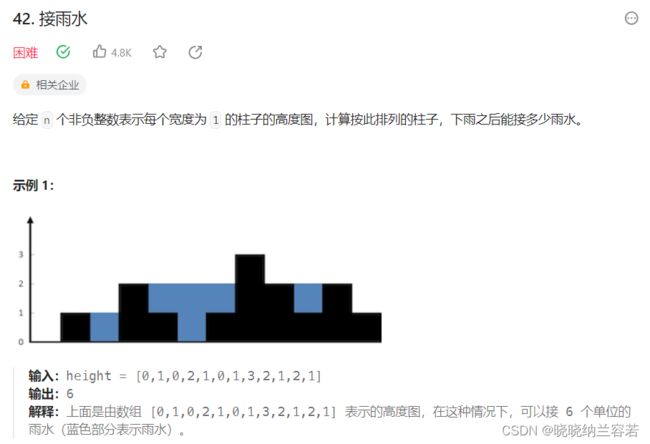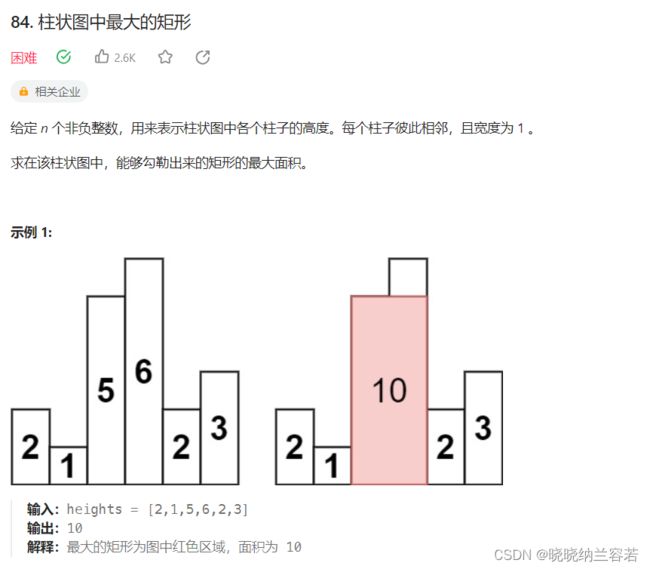代码随想录笔记--单调栈篇
目录
1--单调栈
2--每日温度
3--下一个更大元素I
3--下一个更大元素II
4--接雨水
5--柱状图中最大的矩形
1--单调栈
使用单调栈的特征:寻找第一个比当前元素大或者小的元素。
当题目要求寻找左右第一个比当前栈顶元素大的元素时,使用单调递增的单调栈(从栈顶开始);
当题目要求寻找左右第一个比当前栈顶元素小的元素时,使用单调递减的单调栈(从栈顶开始);
2--每日温度
主要思路:
基于单调栈,单调栈从栈顶开始递增;单调栈存储的是元素对应的索引。
当遇到一个元素大于栈顶元素i时,计算 answer[i]。
#include
#include
#include
class Solution {
public:
std::vector dailyTemperatures(std::vector& temperatures) {
std::vector res(temperatures.size(), 0);
std::stack stk;
for(int i = 0; i < temperatures.size(); i++){
while(!stk.empty() && temperatures[i] > temperatures[stk.top()]){
res[stk.top()] = i - stk.top();
stk.pop();
}
stk.push(i);
}
return res;
}
};
int main(int argc, char* argv[]){
// temperatures = [73,74,75,71,69,72,76,73]
std::vector test = {73, 74, 75, 71, 69, 72, 76, 73};
Solution S1;
std::vector res = S1.dailyTemperatures(test);
for(auto num : res) std::cout << num << " ";
std::cout << std::endl;
return 0;
} 3--下一个更大元素I
主要思路:
基于单调栈和哈希表。
将 nums1 的元素映射为哈希表,其中 key 为 num1[i],val 为 i;
遍历 nums2 构建单调栈,当 nums2[i] > stk.top() 时,且 stk.top() 属于 nums1,表明找到第一个比它大的元素,则根据hash_map[stk.top()]可以知道其在nums1的位置,记录结果res[hash_map[stk.top()]] = nums2[i] 即可。
#include
#include
#include
#include
class Solution {
public:
std::vector nextGreaterElement(std::vector& nums1, std::vector& nums2) {
std::vector res(nums1.size(), -1);
if(nums1.size() == 0) return res;
std::unordered_maphash_map;
for(int i = 0; i < nums1.size(); i++) hash_map.emplace(nums1[i], i); // 存储值,索引
std::stack stk;
for(int i = 0; i < nums2.size(); i++){
while(!stk.empty() && nums2[i] > stk.top()){
if(hash_map.find(stk.top()) != hash_map.end()){
res[hash_map[stk.top()]] = nums2[i];
}
stk.pop();
}
stk.push(nums2[i]);
}
return res;
}
};
int main(int argc, char* argv[]){
// nums1 = [4,1,2], nums2 = [1,3,4,2]
std::vector test1 = {4, 1, 2};
std::vector test2 = {1, 3, 4, 2};
Solution S1;
std::vector res = S1.nextGreaterElement(test1, test2);
for(auto num : res) std::cout << num << " ";
std::cout << std::endl;
return 0;
} 3--下一个更大元素II
主要思路:
基于单调栈,本题的难点是针对一个循环数组,可以通过取模的操作来模拟循环数组。
#include
#include
#include
class Solution {
public:
std::vector nextGreaterElements(std::vector& nums) {
std::vector res(nums.size(), -1);
std::stack stk;
for(int i = 0; i < 2*nums.size(); i++){
// 通过取模操作模拟有环的过程
int idx = i % nums.size();
while(!stk.empty() && nums[idx] > nums[stk.top()]){
res[stk.top()] = nums[idx];
stk.pop();
}
stk.push(idx);
}
return res;
}
};
int main(int argc, char* argv[]){
// nums = [1, 2, 1]
std::vector test = {1, 2, 1};
Solution S1;
std::vector res = S1.nextGreaterElements(test);
for(int num : res) std::cout << num << " ";
std::cout << std::endl;
return 0;
} 4--接雨水
主要思路:
维护一个单调递增的单调栈(从栈顶开始)。当某一个元素比当前栈顶元素大时,计算以该栈顶元素为中心的接雨水面积:area = (当前遍历元素的索引 - 栈顶元素栈中前一个元素的索引)* min(当前遍历元素的高度 - 栈顶元素的高度,栈顶元素栈中前一个元素的高度 - 栈顶元素的高度)
#include
#include
#include
class Solution {
public:
int trap(std::vector& height) {
std::stack stk;
int res = 0;
for(int i = 0; i < height.size(); i++){
while(!stk.empty() && height[i] > height[stk.top()]){
int top_h = height[stk.top()]; // 栈顶元素高度
stk.pop();
if(!stk.empty()){
res += (i - stk.top() - 1) * std::min(height[i] - top_h, height[stk.top()] - top_h);
}
}
stk.push(i);
}
return res;
}
};
int main(int argc, char* argv[]){
// height = [4, 2, 0, 3, 2, 5]
std::vector test = {4, 2, 0, 3, 2, 5};
Solution S1;
int res = S1.trap(test);
std::cout << res << std::endl;
return 0;
} 5--柱状图中最大的矩形
主要思路:
维护一个单调递减的单调栈(从栈顶开始),对于每一个柱子,寻找左右两边比其高度矮的柱子,计算其构成的矩形面积: area = (当前遍历元素的索引 - 栈顶元素在栈中上一个元素的索引 - 1)* 当前栈顶元素的高度;
#include
#include
#include
class Solution {
public:
int largestRectangleArea(std::vector& heights){
int res = 0;
std::stack stk;
heights.insert(heights.begin(), 0);
heights.insert(heights.end(), 0);
for(int i = 0; i < heights.size(); i++){
while(!stk.empty() && heights[i] < heights[stk.top()]){
int cur_idx = stk.top();
stk.pop();
if(!stk.empty()){
res = std::max(res, (i - stk.top() - 1)*heights[cur_idx]);
}
}
stk.push(i);
}
return res;
}
};
int main(int argc, char* argv[]){
// heights = [2, 1, 5, 6, 2, 3]
std::vector test = {2, 1, 5, 6, 2, 3};
Solution S1;
int res = S1.largestRectangleArea(test);
std::cout << res << std::endl;
return 0;
} 代码随想录 ended in 2023.10.24 !!!




